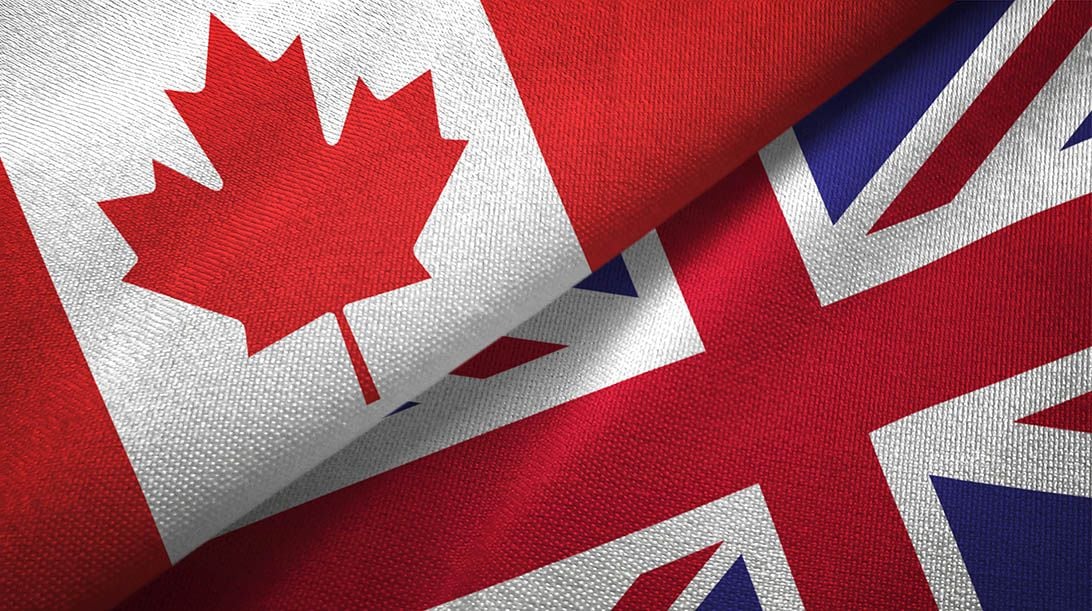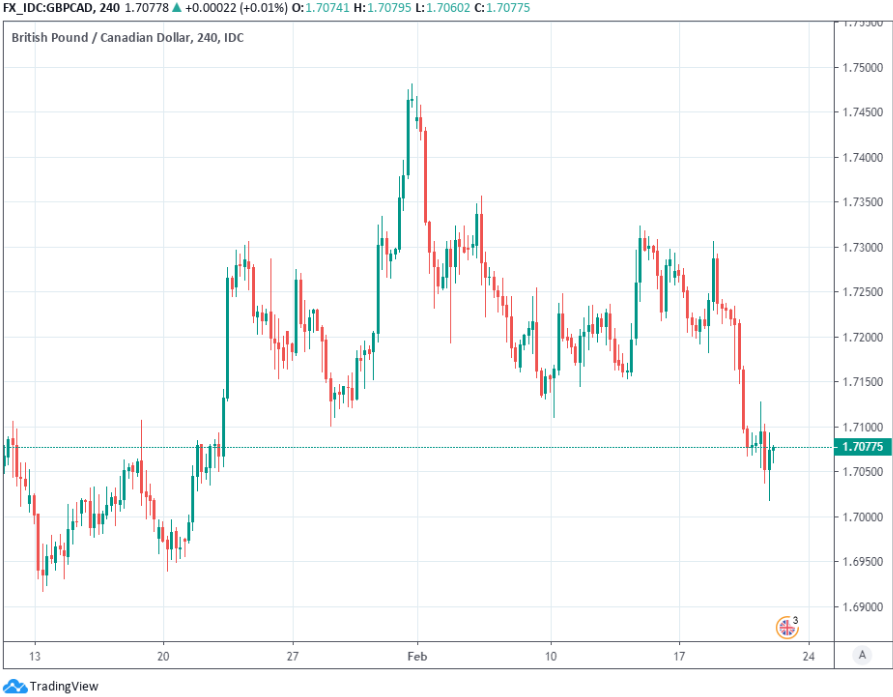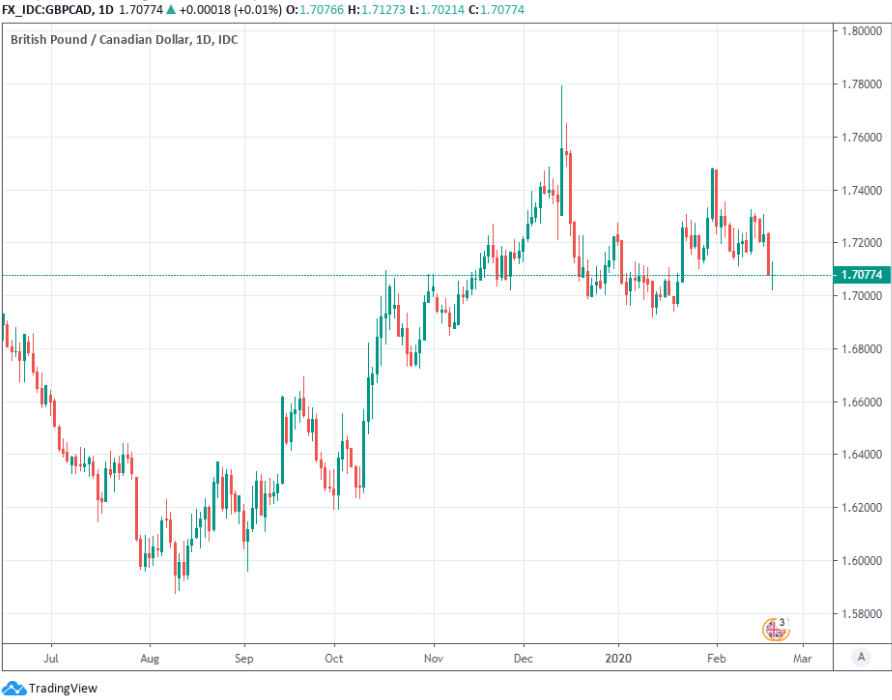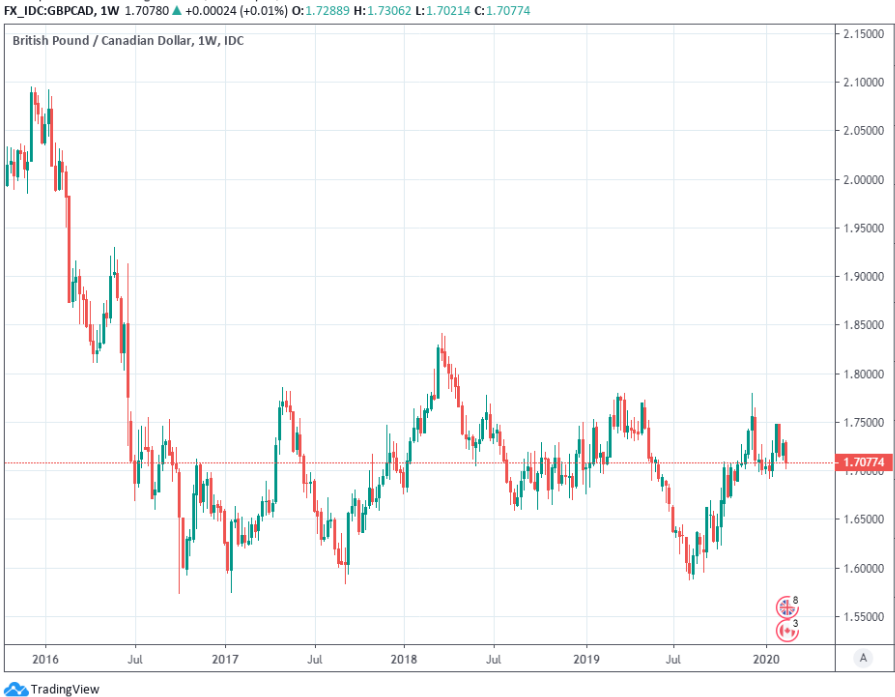CIBC Downgrade Pound-Canadian Dollar Rate Forecasts
- Written by: James Skinner

Image © Adobe Stock
- GBP/CAD Spot rate: 1.7106, down +0.15% today.
- Indicative bank rates for transfers: 1.6483-1.6603
- Transfer specialist indicative rates: 1.6850-1.6927 >> Get your quote now
The Pound has had its wings clipped this week and could be slow to regain the initiative over the Canadian Dollar in the coming months, according to the latest CIBC Capital Markets forecasts which were downgraded on Thursday due to lingering concerns about the UK economic outlook.
Pound Sterling has been resilient against most major counterparts this week but it's ceded ground to the Canadian Dollar while also coming under pressure from the safe-haven U.S. greenback and Swiss Franc. The Canadian Dollar has been boosted this week by a recovery in oil prices.
The Pound-to-Canadian Dollar rate was down -0.35% for the week Friday although CIBC’s downgraded forecasts suggest Sterling’s losses are over, albeit that the eventual recovery is tipped to be shallower than it once was.
“The UK’s economy narrowly avoided a contraction in its Q4 GDP figures, which provided some relief for sterling,” says Jeremy Stretch, a London-based strategist at Canada’s CIBC. “However, with consumption experiencing its weakest quarter since 2015, the avoidance of a negative GDP reading was largely a function of an aggressive uptick in government spending.”
Above: Pound-to-Canadian Dollar rate shown at 4-hour intervals.
CIBC says a 2.1% increase in overall government spending was the main driver behind the UK’s narrow escape from an economic contraction in the final quarter last year, with both businesses and the consumer having ghosted on statisticians during a period in which all were dogged by uncertainty over a delayed October 31 EU departure date and the December general election.
The consumer has been a linchpin of the UK’s slowing economy in the post-referendum years, which have seen the international backdrop turn from tailwind to headwind and businesses go on strike as far as investment is concerned.
“Absent government spending, activity would have likely struggled to remain positive in 2019, as business investment has still been stalling amidst Brexit debates,” Stretch says.
Even households’ once insatiable appetites for spending appear to have been curtailed in recent months. Retail sales bounced by a strong 0.9% in January, the Office for National Statistics revealed Thursday, but sales had fallen by a larger -1.3% over the prior two months.
And whether households continue to keep their belts tightened could be key to developments in Sterling exchange rates over the coming months because the Pound was spared an interest rate cut in January due to a widespread assumption the government will increase its spending in the March 11 budget.
Above: Pound-to-Canadian Dollar rate shown at daily intervals.
“The new Chancellor faces a challenging balancing act with respect to the upcoming budget,” Stretch says. “With consumers and businesses still hesitant to spend and invest - at least until we see clarity surrounding trade negotiations - the fiscal impulse will continue to be important. “
The problem for the Pound is that when the Bank of England (BoE) decided to leave interest rates unchanged in January, prompting markets to bid Sterling higher, most were assuming a so-called “Boris Bounce” in the economy would materialise during the months ahead.
That bounce, when combined with budgetary stimulus, was supposed to lift the economy from March to a growth pace that is sufficient enough for a BoE to avoid an interest rate cut later this year.
Sterling’s recent gains were largely the result of a belief in the market that such stimulus would see Bank Rate left unchanged through much of 2020.
Above: Pound-to-Canadian Dollar rate shown at weekly intervals.
Market expectations mean that if a “Boris Bounce” in both consumer and government spending is not forthcoming in the months ahead, then investors might return to betting that a rate cut comes out of the pipeline sooner or later.
“Should growth continue to undershoot trend levels through H1 - despite potential fiscal injections – we’d be wary of market expectations of increased BoE stimulus. As a result, GBP impetus is likely to remain modest through H1 this year,” Stretch says.
CIBC forecasts the Pound-to-Canadian Dollar rate will remain around 1.70 until the end of March before climbing back to only 1.73 in the second quarter, which are downgrades from earlier projections of 1.71 and 1.74 respectively.
Pound Sterling is seen ending the year at 1.82 after climbing from 1.77 at the end of the third quarter, with both numbers being downgraded from the 1.81 and 1.87 levels envisaged previously.







